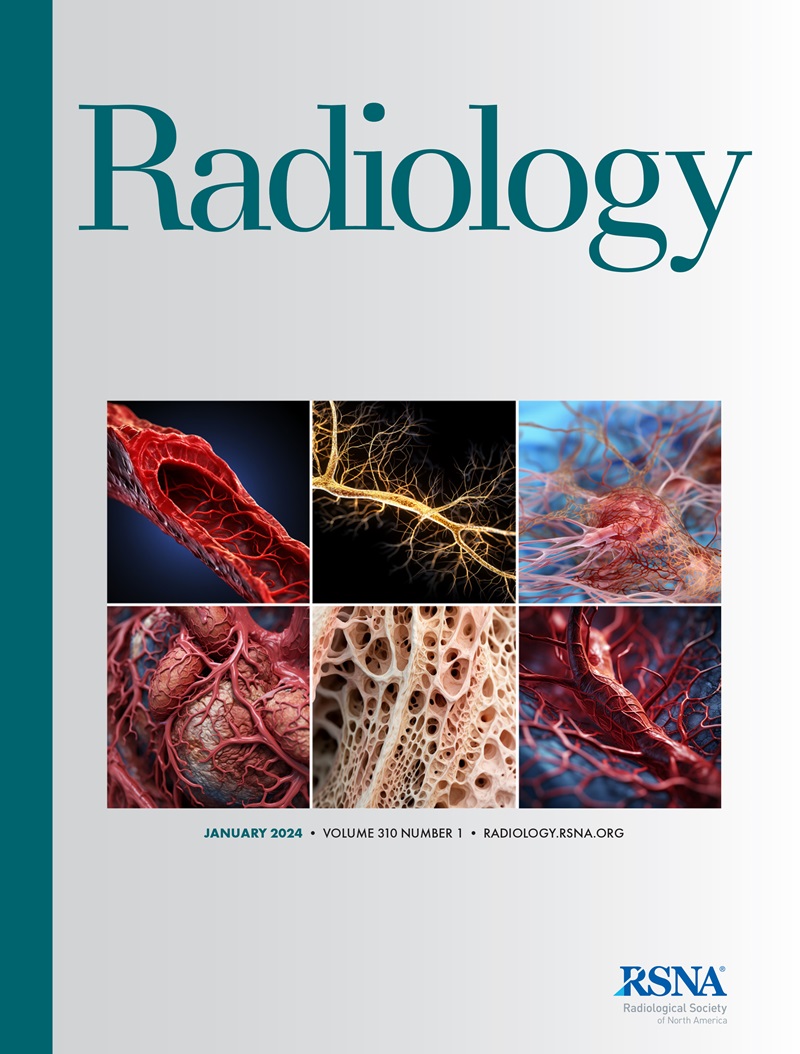Jiyoung Yoon, Kyunghwa Han, Seungchan Nahm, Min Jung Kim, Jung Hyun Yoon, Miribi Rho, Vivian Youngjean Park
求助PDF
{"title":"有乳腺癌病史的女性的乳腺MRI监测:与晚期第二乳腺癌发生的关系","authors":"Jiyoung Yoon, Kyunghwa Han, Seungchan Nahm, Min Jung Kim, Jung Hyun Yoon, Miribi Rho, Vivian Youngjean Park","doi":"10.1148/radiol.240119","DOIUrl":null,"url":null,"abstract":"<p><p>Background Studies on the association between surveillance breast MRI in women with a personal history of breast cancer (PHBC) and advanced second breast cancer are lacking. Purpose To investigate the association between postoperative surveillance breast MRI and advanced second breast cancer in women with a PHBC by using propensity score matching (PSM). Materials and Methods Women who underwent breast cancer surgery between January 2009 and December 2014 were retrospectively identified at a single tertiary center. Second breast cancer was defined as ipsilateral or contralateral breast cancer diagnosed at least 1 year after surgery, and advanced second breast cancer was defined as second breast cancer <i>(a)</i> grade T2 or higher or lymph node-positive or <i>(b)</i> T1c triple-negative or human epidermal growth factor receptor 2-positive. Women who underwent surveillance MRI and those who did not were matched using propensity scores according to 13 clinical-pathologic characteristics. Outcomes were compared using logistic regression analysis. Results Among the 3688 women (mean age, 51.1 years ± 10.5 [SD]), 2130 underwent surveillance MRI (MRI group) and 1558 did not (non-MRI group); 1062 patient pairs were matched. Advanced second breast cancer proportions for non-MRI and MRI groups were 1.7% (27 of 1558 participants) and 0.4% (eight of 2130 participants) before PSM and 1.6% (17 of 1062 participants) and 0.7% (seven of 1062) after PSM. Surveillance MRI was associated with lower odds of advanced second breast cancer before PSM (odds ratio [OR], 0.21 [95% CI: 0.10, 0.47]; <i>P</i> < .001) and after PSM (OR, 0.41 [95% CI: 0.17, 0.99]; <i>P</i> = .048). The proportion of symptomatic second breast cancers was higher in the non-MRI group before PSM (25% [16 of 65 second cancers] vs 6.4% [three of 47]; <i>P</i> = .01) and after PSM (21% [10 of 48] vs 3.2% [one of 31]; <i>P</i> = .003). Conclusion In women with a PHBC, MRI surveillance was associated with lower odds of advanced second breast cancer before and after PSM. © RSNA, 2025 <i>Supplemental material is available for this article.</i></p>","PeriodicalId":20896,"journal":{"name":"Radiology","volume":"314 1","pages":"e240119"},"PeriodicalIF":12.1000,"publicationDate":"2025-01-01","publicationTypes":"Journal Article","fieldsOfStudy":null,"isOpenAccess":false,"openAccessPdf":"","citationCount":"0","resultStr":"{\"title\":\"Surveillance Breast MRI in Women with a History of Breast Cancer: Association with Occurrence of Advanced Second Breast Cancer.\",\"authors\":\"Jiyoung Yoon, Kyunghwa Han, Seungchan Nahm, Min Jung Kim, Jung Hyun Yoon, Miribi Rho, Vivian Youngjean Park\",\"doi\":\"10.1148/radiol.240119\",\"DOIUrl\":null,\"url\":null,\"abstract\":\"<p><p>Background Studies on the association between surveillance breast MRI in women with a personal history of breast cancer (PHBC) and advanced second breast cancer are lacking. Purpose To investigate the association between postoperative surveillance breast MRI and advanced second breast cancer in women with a PHBC by using propensity score matching (PSM). Materials and Methods Women who underwent breast cancer surgery between January 2009 and December 2014 were retrospectively identified at a single tertiary center. Second breast cancer was defined as ipsilateral or contralateral breast cancer diagnosed at least 1 year after surgery, and advanced second breast cancer was defined as second breast cancer <i>(a)</i> grade T2 or higher or lymph node-positive or <i>(b)</i> T1c triple-negative or human epidermal growth factor receptor 2-positive. Women who underwent surveillance MRI and those who did not were matched using propensity scores according to 13 clinical-pathologic characteristics. Outcomes were compared using logistic regression analysis. Results Among the 3688 women (mean age, 51.1 years ± 10.5 [SD]), 2130 underwent surveillance MRI (MRI group) and 1558 did not (non-MRI group); 1062 patient pairs were matched. Advanced second breast cancer proportions for non-MRI and MRI groups were 1.7% (27 of 1558 participants) and 0.4% (eight of 2130 participants) before PSM and 1.6% (17 of 1062 participants) and 0.7% (seven of 1062) after PSM. Surveillance MRI was associated with lower odds of advanced second breast cancer before PSM (odds ratio [OR], 0.21 [95% CI: 0.10, 0.47]; <i>P</i> < .001) and after PSM (OR, 0.41 [95% CI: 0.17, 0.99]; <i>P</i> = .048). The proportion of symptomatic second breast cancers was higher in the non-MRI group before PSM (25% [16 of 65 second cancers] vs 6.4% [three of 47]; <i>P</i> = .01) and after PSM (21% [10 of 48] vs 3.2% [one of 31]; <i>P</i> = .003). Conclusion In women with a PHBC, MRI surveillance was associated with lower odds of advanced second breast cancer before and after PSM. © RSNA, 2025 <i>Supplemental material is available for this article.</i></p>\",\"PeriodicalId\":20896,\"journal\":{\"name\":\"Radiology\",\"volume\":\"314 1\",\"pages\":\"e240119\"},\"PeriodicalIF\":12.1000,\"publicationDate\":\"2025-01-01\",\"publicationTypes\":\"Journal Article\",\"fieldsOfStudy\":null,\"isOpenAccess\":false,\"openAccessPdf\":\"\",\"citationCount\":\"0\",\"resultStr\":null,\"platform\":\"Semanticscholar\",\"paperid\":null,\"PeriodicalName\":\"Radiology\",\"FirstCategoryId\":\"3\",\"ListUrlMain\":\"https://doi.org/10.1148/radiol.240119\",\"RegionNum\":1,\"RegionCategory\":\"医学\",\"ArticlePicture\":[],\"TitleCN\":null,\"AbstractTextCN\":null,\"PMCID\":null,\"EPubDate\":\"\",\"PubModel\":\"\",\"JCR\":\"Q1\",\"JCRName\":\"RADIOLOGY, NUCLEAR MEDICINE & MEDICAL IMAGING\",\"Score\":null,\"Total\":0}","platform":"Semanticscholar","paperid":null,"PeriodicalName":"Radiology","FirstCategoryId":"3","ListUrlMain":"https://doi.org/10.1148/radiol.240119","RegionNum":1,"RegionCategory":"医学","ArticlePicture":[],"TitleCN":null,"AbstractTextCN":null,"PMCID":null,"EPubDate":"","PubModel":"","JCR":"Q1","JCRName":"RADIOLOGY, NUCLEAR MEDICINE & MEDICAL IMAGING","Score":null,"Total":0}
引用次数: 0
引用
批量引用

 求助内容:
求助内容: 应助结果提醒方式:
应助结果提醒方式:


